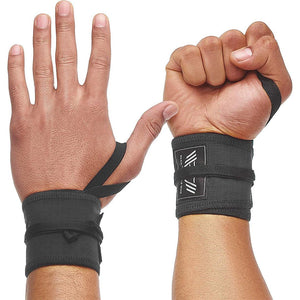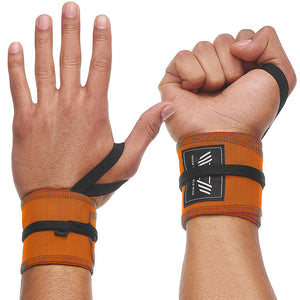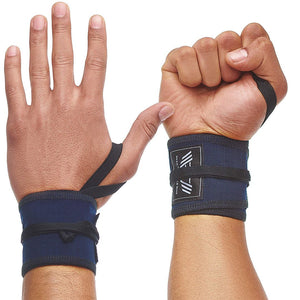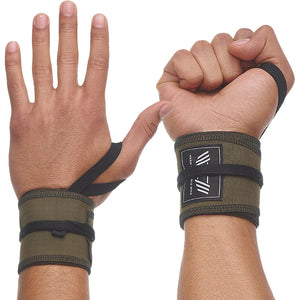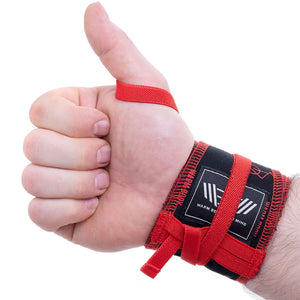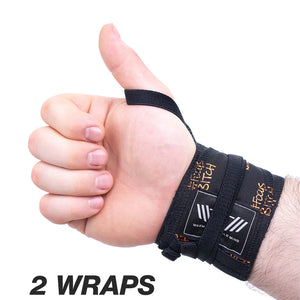Discover top-quality weightlifting wrist wraps for ultimate wrist support. Elevate your workout with our durable and comfortable wrist wraps. Shop now and lift with confidence!
What Are Wrist Wraps?
Lifting wrist wraps are a blend of simplicity and functionality. They are essentially strips of material, designed to encircle the wrists, providing sufficient support. Their purpose is to fortify the wrists against the immense pressure exerted during heavy lifts and to act as a shield against potential injuries. This sports garment is a helping tool in the pursuit of personal bests and broken records.
In the vast landscape of wrist wraps, three types stand out as the most common: the cotton wrist wraps, the velcro wrist wraps, and the leather weightlifting wrist support. Each of these wraps, with their unique material composition, offers a different level of support, comfort, and flexibility, catering to the diverse needs of lifters.
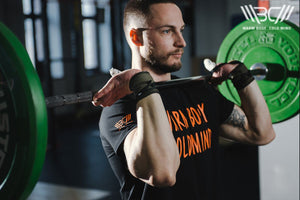
Cotton Wrist Wraps
Cotton wrist wraps are the embodiment of comfort and versatility. They are known for their softness and flexibility, providing a balance of comfort and support that is hard to match.
The cotton powerlifting wrist wraps, with their breathable and pliable fabric, are designed to be a lifter's second skin. They mold to the shape of the wrist, providing a snug fit without restricting movement. This adaptability makes them an excellent choice for exercises that require a wide range of motion, allowing the wrist to flex and extend naturally without compromising on support.
Despite their softness, cotton wrist wraps for lifting are far from fragile. They are engineered to withstand the rigors of regular use, demonstrating a durability that belies their gentle feel. These wraps can endure the pressures of repetitive use, maintaining their shape and function over time.
One unique feature of cotton wrist support for lifting is their ability to absorb sweat — a characteristic that enhances their comfort during prolonged workouts. Unlike other materials that may become slippery or uncomfortable when wet, cotton maintains its grip and feel, ensuring that the wraps remain effective even as your workout intensifies.
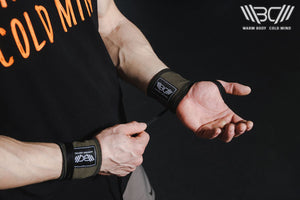
Velcro Wrist Wraps
These wraps, made of resilient nylon, are designed to provide robust support and adaptability. Their defining feature is a thumb loop and a velcro fastener, a duo that allows a lifter to adjust the tightness of the wrap to their personal comfort and need.
They are capable of adapting quickly to the changing demands of a workout. Their adjustability allows for quick and easy modifications, ensuring that the level of support provided can be fine-tuned to match the specific requirements of the lift being performed.
Velcro weightlifting wrist wraps are designed to provide robust support, making them ideal for exercises that require the wrists to resist high amounts of pressure, protecting frompotential injury.
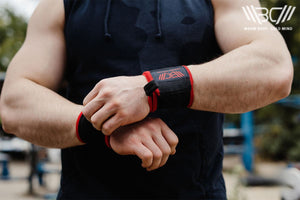
Leather Wrist Wraps
Leather wrist wraps for weightlifting are the most durable type. They offer the highest level of support and are typically used by powerlifters and bodybuilders. However, the leather material is not as breathable as cotton, and these wraps may not be as comfortable for long wear.
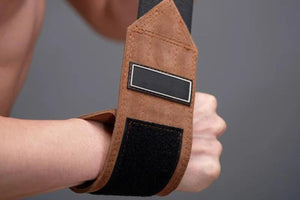
Why Do You Need Wrist Wraps?
Wrist wraps are more than just a piece of fitness gear: they cater to the needs of athletes and fitness enthusiasts, providing an array of benefits that enhance performance and reduce the risk of injuries. Let's delve into the reasons why you might need wrist wraps for weightlifting and the advantages they bring to your training regime.
Benefit 1: Joint Stability and Support
One of the primary roles of wrist wraps is to provide stability and support for the wrist joints, particularly during heavy lifting or exercises that exert significant strain on the wrists. By stabilizing the joints, wrist wraps reduce the risk of overextension or excessive movement that can lead to strains or sprains. This protective wrist support for lifting joints helps resist bending under high pressure, making them a popular choice among strength athletes or individuals starting to lift heavier loads.
Benefit 2: Enhanced Grip Strength
Wrist wraps can indirectly enhance your grip strength, particularly for exercises that involve gripping, such as deadlifts, rows, chin-ups, etc. When you wear wrist wraps for lifting, your fingers will squeeze harder around the bar, providing a stronger grip. This effect is especially beneficial for powerlifters who need to maintain a firm grip during heavy lifts.
Benefit 3: Improved Technique
Gym wrist wraps can help improve your lifting technique by maintaining proper wrist alignment. They ensure that your wrist stays in a neutral position under load, which can enhance the strength and technique of your movements. This benefit is especially crucial for beginners who are still learning proper form and for more advanced lifters who are working with heavier weights.
Benefit 4: Injury Prevention
By providing additional support and stability to your wrists, lifting wrist wraps can help reduce the risk of injuries. They act as a supportive shield, absorbing some of the force and distributing it evenly across the wrist joint. It not only helps to prevent injuries but also allows individuals to perform at their best without worrying about wrist discomfort or instability. This makes them particularly beneficial for individuals with weak or unstable weightlifting wrist support, whether due to a previous injury or a natural predisposition.
Benefit 5: Enhanced Training Intensity
Weightlifting wrist wraps can potentially enhance your training intensity by enabling you to lift heavier weights more safely. By providing stability and reducing the risk of injury, you can push your limits and increase the intensity of your workouts. This can lead to more significant strength gains over time.
How to Pick Wrist Wraps
Choosing powerlifting wrist wraps is not a one-size-fits-all process. It involves a keen understanding of your specific needs and a careful evaluation of the available options. Here are some tips to help you navigate the sea of wrist wraps and find the one that fits you like a glove.
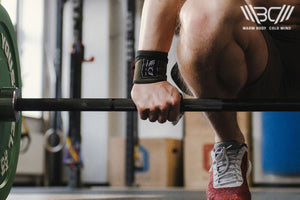
Tip 1: Understand Your Training Needs
Your training regimen should be the primary determinant of the type of wrist wraps you choose. If your routine involves heavy lifting, you might need gym wrist wraps that offer maximum support, like velcro or leather wraps. On the other hand, if your workouts require more flexibility and range of motion, cotton wraps might be a better choice. Understand the demands of your training and choose a wrap that can meet those needs.
Tip 2: Consider the Material
The material of the wrist wraps for lifting can influence their comfort, durability, and level of support. Cotton wraps are usually more comfortable and breathable, while nylon (velcro) and leather wraps offer more support and are more durable. Consider the trade-offs and choose a material that best suits your requirements.
Tip 3: Check the Secure Mechanism
The secure mechanism of the wrist wraps is another important factor to consider. Most wrist wraps use a thumb loop and Velcro for fastening, which allows for adjustability. However, some wraps use a unique "Belt Loop Tightening System," which acts like a belt to your wrist, providing support without the hassle of thumb loops. Ensure the fastening mechanism is secure, easy to adjust, and comfortable.
Tip 4: Look at the Length of the Wrap
Wrist wraps come in different lengths, and the length can affect the level of support the wraps provide. Longer wraps offer more support but might be bulkier and less comfortable. Shorter wraps might be more comfortable and flexible but offer less support. Choose a length that offers a good balance of support and comfort for your needs.
Tip 5: Consider Stiffness
The stiffness of the lifting wrist wraps can impact the level of support they provide. If you are working with heavy weights, you might need stiffer wraps for better wrist protection. Some brands offer wraps with varying degrees of stiffness, allowing you to choose the right level of support for your training needs.
How to Use Wrist Wraps
Harnessing the power of weightlifting wrist wraps requires wearing them correctly. Here is a step-by-step guide to help you unlock the full potential of your wrist wraps.
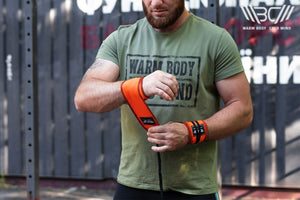
Tip 1: Positioning the Wrap
The thumb loop should be the starting point of your wrap journey. Ensure that the loop is pointing upward, and the long fabric strip lays on the inside of your wrist. The velcro portion should be facing up, ready to secure the wrap once it's fully wrapped around your wrist.
Tip 2: Wrapping Technique
Insert your thumb through the loop and begin to wrap the fabric around your wrist. The wrap should be snug but comfortable, not too tight to cut off circulation or too loose to render it ineffective. The wrap should cover the wrist joint but not extend too far up the forearm or down the hand. It's essential to maintain a balance between comfort and support.
Tip 3: Adjusting the Tightness
One of the advantages of gym wrist wraps is their adjustability. Depending on the exercise you're performing, you can adjust the tightness of the wrap to provide the right level of support. For heavy lifts that require more wrist stability, you might want to tighten the wraps, and for exercises that require more wrist mobility, you can loosen them a bit.
Tip 4: Use the Wraps Appropriately
It's crucial to use powerlifting wrist wraps only when necessary. They are not meant to be worn throughout your entire workout, especially if your workout involves exercises that don't put much strain on your wrists. Over-reliance on wrist wraps may hinder the development of your wrist and forearm muscles.
Tip 5: Wrap Maintenance
Maintaining your wrist wraps is key to their longevity. After each workout, it's a good idea to air them out to prevent any build-up of sweat and bacteria. Regularly check your wraps for any signs of wear and tear. Despite their durability, wrist wraps for lifting are not invincible and will need to be replaced over time.
FAQs
Do wrist wraps make you stronger?
While wrist wraps can provide additional support and stability, they do not directly increase your strength. The key to strength gain is through proper form, adequate training, and nutrition. However, by reducing the risk of injury and improving your lifting technique, workout wrist wraps can contribute to your overall performance and strength gains.
Are wrist wraps good for beginners?
Lifting wrist wraps can be beneficial for beginners, especially those who are new to heavy lifting. They can help prevent injuries and improve lifting technique, making them a valuable tool for beginners. However, it's important to use them correctly and not rely on them for proper form and technique.
Do wrist wraps increase bench max?
While wrist wraps can provide additional support and stability, they do not directly increase your bench max. Nonetheless, by reducing the risk of injury and allowing you to perform more reps with proper form, they can contribute to your overall performance and progress.
When should I start using lifting wraps?
You should consider starting to use weightlifting wrist support when you are lifting weights that put a lot of strain on your wrists, or when you are performing exercises that require a lot of wrist movement. If you are new to heavy lifting, it might be a good idea to start using them to prevent injuries and improve your lifting technique
Should I get lifting straps or wrist wraps?
The choice between lifting straps and wrist wraps depends on your needs and preferences. Lifting straps provide a wider range of motion and are often more comfortable for long periods of use. Wrist wraps, on the other hand, provide more stability and support, making them a better choice for heavy lifting or high-intensity workouts.







